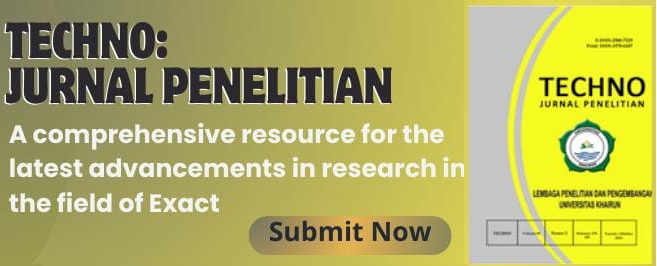Formulasi Konsorsium Bakteri Endofit untuk Menekan Infeksi Nematoda Puru Akar Meloidogyne incognita pada Tomat
Abstract
The root-knot nematodes (Meloidogyne incognita) infection can cause a significant yield loss in tomato plants. One of the environmentally friendly efforts to control this nematode is through the application of endophytic bacteria. The application of endophytic bacteria in the form of a consortium was reported to be more effective than the application using a single isolate. This study aims to test the effectiveness of the endophytic bacteria consortium formula in suppressing M. incognita infection in tomato plants. The research stages were the selection of the consortium of endophytic bacteria as a growth promoter for tomato plants infected with M. incognita. The best performing consortium was formulated using 100 g of grass compost + 100 g vermicompost + 10 ml molasses + 1 g peptone and 50 ml distilled water. The test of bacterial cell viability in the endophytic formula was carried out for 20 weeks. The formula made was tested for its performance as a biocontrol agent against M. incognita in tomato plants. The results showed that three consortia gave the best results as growth promoters of M. incognita infected tomatoes, namely TmtN5, TmtN2, and GsgN2. The three of them survived the formula with log CFU at week 20 of 6.07 (TmtN5), 5.56 (TmtN2), and 6.11 (GsgN2). This formula can suppress the nematode population on tomato plants' roots and suppress the number of root knots in tomato plants. This study provides information that there are three consortia of endophytic bacteria (TmtN5, TmtN2, and GsgN2), which have the potential to become biological control agents for root-purulent nematodes.
Keywords
Full Text:
PDF (Bahasa Indonesia)References
Anjum, R., Afzal, M., Baber, R., Khan, M.A.J., Kanwal, W., Sajid, W., dan Raheel, A. 2019. Endophytes: as potential biocontrol agentâ€â€review and future prospects. Journal of Agricutural Science. 11: 113-125. doi: 10.5539/jas.v11n4p113.
Ashraf, S., Afzal, M., Naveed, M., Shahid, M., dan Ahmad, Z. 2018. Endophytic bacteria enhance remediation of tannery effluent in constructed wetlands vegetated with Leptochloa fusca. International Journal of Phytoremediation. 20(2): 121-128. doi: 10.1080/15226514.2017.1337072.
Basheer, J., Ravi, A., Mathew, J., dan Krishnankutty, R.E. 2019. Assessment of plant-probiotic performance of novel endophytic Bacillus sp. in talc-based formulation. Probiotics and Antimicrobial Proteins. 11(1): 256-263. doi: 10.1007/s12602-018-9386-y.
Bora, P., Saikia, K., Hazarkia, H., dan Ragesh, G. 2019. Exploring potential of bacterial endophytes in disease management of horticultural crops. Current Horticulture. 7(2): 32-37. doi: 10.5958/2455-7560.2019.00016.5.
Brader, G., Compant, S., Mitter, B., Trognitz, F., dan Sessitsch, A. 2014. Metabolic potential of endophytic bacteria. Current Opinion in Biotechnology. 27: 30-37. doi: 10.1016/j.copbio.2013.09.012.
Brand, D., Roussos, S., Pandey, A., Zilioli, P.C., Pohl, J., dan Soccol, C.R. 2004. Development of a bionematicide with Paecilomyces lilacinus to control Meloidogyne incognita. Applied Biochemistry and Biotechnology. 118(1-3): 81-88. doi: 10.1385/ABAB:118:1-3:081.
Cetintas, R., Kusek, M., dan Fateh, S.A. 2018. Effect of some plant growth-promoting rhizobacteria strains on root-knot nematode, Meloidogyne incognita, on tomatoes. Egyptian Journal of Biological Pest Control. 28(1): 1-5. doi: 10.1186/s41938-017-0008-x.
Chawla, G., Singh, K.P., dan Srivastava, A. 2006. Study on propagation of root knot nematode, Meloidogyne incognita (Kof oid & White) Chitwood, through tuberose (Polianthes tuberosa Linn.) bulbs. Journal of Ornamental Horticulture. 9(1): 73-74.
Chebotar, V., Malfanova, N., Shcherbakov, A., Ahtemova, G., Borisov, A.Y., Lugtenberg, B., dan Tikhonovich, I. 2015. Endophytic bacteria in microbial preparations that improve plant development. Applied Biochemistry and Microbiology. 51(3): 271-277. doi: 10.1134/S0003683815030059.
Dias, A.C., Costa, F.E., Andreote, F.D., Lacava, P.T., Teixeira, M.A., Assumpçao, L.C., Araújo, W.L., Azevedo, J.L., dan Melo, I.S. 2009. Isolation of micropropagated strawberry endophytic bacteria and assessment of their potential for plant growth promotion. World Journal of Microbiology and Biotechnology. 25(2): 189-195. doi: 10.1007/s11274-008-9878-0.
Eljounaidi, K., Lee, S.K., dan Bae, H. 2016. Bacterial endophytes as potential biocontrol agents of vascular wilt diseases–review and future prospects. Biological Control. 103: 62-68. doi: 10.1016/j.biocontrol.2016.07.013.
Furusawa, A., Uehara, T., Ikeda, K., Sakai, H., Tateishi, Y., Sakai, M., dan Nakaho, K. 2019. Ralstonia solanacearum colonization of tomato roots infected by Meloidogyne incognita. Journal of Phytopathology. 167(6): 338-343. doi: 10.1111/jph.12804.
Hu, H.J., Chen, Y.L, Wang, Y.F., Tang, Y.Y., Chen, S.L., dan Yan, S.Z. 2017. Endophytic Bacillus cereus effectively controls Meloidogyne incognita on tomato plants through rapid rhizosphere occupation and repellent action. Plant Disease. 101(3): 448-455. doi: 10.1094/PDIS-06-16-0871-RE.
Khanna, K., Jamwal, V.L., Kohli, S.K., Gandhi, S.G., Ohri, P., Bhardwaj, R., Wijaya, L., Alyemeni, M.N., dan Ahmad, P. 2019. Role of plant growth promoting Bacteria (PGPRs) as biocontrol agents of Meloidogyne incognita through improved plant defense of Lycopersicon esculentum. Plant and Soil. 436(1-2): 325-345. doi: 10.1007/s11104-019-03932-2.
Kumar, N., Bhatt, J., dan Sharma, R.L. 2017. Interaction between Meloidogyne incognita with Fusarium oxysporum f. sp. lycpersici on Tomato. International Journal of Current Microbiology and Applied Sciences. 6: 1770-1776. doi: 10.20546/ijcmas.2017.608.209.
Ludwig-Müller, J. 2015. Plants and endophytes: equal partners in secondary metabolite production? Biotechnology Letters. 37(7): 1325-1334. doi: 10.1007/s10529-015-1814-4.
Mercer, C., Greenwood, D., dan Grant, J. 1992. Effect of plant and microbial chitinases on the eggs and juveniles of Meloidogyne hapla Chitwood (Nematoda: Tylenchida). Nematologica. 38(1-4): 227-236. doi: 10.1163/187529292X00199.
Miller, P., dan Sands, D. 1977. Effects of hydroclytic enzymes on plant-parasitic nematodes. Journal of Nematology. 9(3): 192-197.
Muhae-ud-Din, G., Moosa, A., Ghummen, U.F., Jabran, M., Abbas, A., Naveed, M., Jabbar, A., dan Ali, M.A. 2018. Host status of commonly planted ornamentals to Meloidogyne incognita and management through endophytic bacteria. Pakistan Journal of Zoology. 50(4): 1393-1402. doi: 10.17582/journal.pjz/2018.50.4.1393.1402.
Mukherjee, G., Saha, C., Naskar, N., Mukherjee, A., Mukherjee, A., Lahiri, S., Majumder, A.L., dan Seal, A. 2018. An endophytic bacterial consortium modulates multiple strategies to improve arsenic phytoremediation efficacy in Solanum nigrum. Scientific Reports. 8(1): 1-16. doi: 10.1038/s41598-018-25306-x.
Munif, A., dan Giyanto, G. 2015. Effectiveness of endophytic bacterial consortium of coffee plant on mortality of Pratylenchus coffeae in vitro. Pelita Perkebunan. 31(3): 175-185.
Munif, A., Hallmann, J., dan Sikora, R.A. 2013. The influence of endophytic bacteria on Meloidogyne incognita infection and tomato plant growth. ISSAAS. 19(2): 68-74.
Munif, A., Herliyana, E.N., dan Pradana, A.P. 2019. Endophytic bacterial consortium originated from forestry plant roots and their nematicidal activity against Meloidogyne incognita infestation in greenhouse. Acta Universitatis Agriculturae et Silviculturae Mendelianae Brunensis. 67(5): 1171-1182. doi: 10.11118/actaun201967051171.
Munif, A., Mutaqin, K.H. 2016. Lama penyimpanan, karakterisasi fisiologi, dan viabilitas bakteri endofit Bacillus sp. dalam formula tepung. Jurnal Fitopatologi Indonesia. 12(1): 19-26. doi: 10.14692/jfi.12.1.19.
Ntalli, N., dan Caboni, P. 2017. A review of isothiocyanates biofumigation activity on plant parasitic nematodes. Phytochemistry Reviews. 16(5): 827-834. doi: 10.1007/s11101-017-9491-7.
Ojiambo, P., dan Scherm, H. 2006. Biological and application-oriented factors influencing plant disease suppression by biological control: a meta-analytical review. Phytopathology. 96(11): 1168-1174. doi: 10.1094/PHYTO-96-1168.
Pradana, A,P., Munif, A., dan Supramana, S. 2016. Bakteri endofit asal berbagai akar tanaman sebagai agens pengendali nematoda puru akar Meloidogyne incognita pada tomat. Jurnal Fitopatologi Indonesia. 12(3): 75-75. doi: 10.14692/jfi.12.3.75.
Qiuhong, N., Xiaowei, H., Baoyu, T., Jinkui, Y., Jiang, L., Lin, Z., dan Keqin, Z. 2006. Bacillus sp. B16 kills nematodes with a serine protease identified as a pathogenic factor. Applied Microbiology and Biotechnology. 69(6): 722-730. doi: 10.1007/s00253-005-0019-5.
Raymaekers, K., Ponet, L., Holtappels, D., Berckmans, B., dan Cammue, B.P. 2020. Screening for novel biocontrol agents applicable in plant disease management–a review. Biological Control. 144: 1-18. doi: 10.1016/j.biocontrol.2020.104240.
Safni, I., Lubis, K., Tantawi, A.R., dan Murthi, S. 2018. Isolation and characterization of rhizobacteria for biological control of root-knot nematodes in indonesia. Journal of the International Society for Southeast Asian Agricultural Sciences. 24(1): 67-81.
Siddiqui, I.A., Haas, D., dan Heeb, S. 2005. Extracellular protease of Pseudomonas fluorescens CHA0, a biocontrol factor with activity against the root-knot nematode Meloidogyne incognita. Applied and Environmental Microbiology. 71(9): 5646-5649. doi: 10.1128/AEM.71.9.5646-5649.2005.
Singh, M., Kumar, A., Singh, R., dan Pandey, K.D. 2017. Endophytic bacteria: a new source of bioactive compounds. 3 Biotech. 7(5): 315-321. doi: 10.1007/s13205-017-0942-z.
Varkey, S., Anith, K., Narayana, R., dan Aswini, S. 2018. A consortium of rhizobacteria and fungal endophyte suppress the root-knot nematode parasite in tomato. Rhizosphere. 5: 38-42. doi: 10.1016/j.rhisph.2017.11.005.
Viljoen, J.J., Labuschagne, N., Fourie, H., dan Sikora, R.A. 2019. Biological control of the root-knot nematode Meloidogyne incognita on tomatoes and carrots by plant growth-promoting rhizobacteria. Tropical Plant Pathology. 44(3): 284-291. doi: 10.1007/s40858-019-00283-2.
Xiang, N., Lawrence, K.S., Kloepper, J.W., Donald, P.A., McInroy, J.A., dan Lawrence, G.W. 2017. Biological control of Meloidogyne incognita by spore-forming plant growth-promoting rhizobacteria on cotton. Plant Disease. 101(5): 774-784. doi: 10.1094/PDIS-09-16-1369-RE.
Yousif, A.I., Munif, A., dan Mutaqin, K.H. 2017. Evaluating the toxicity of secondary metabolites of endophytic bacteria from Jatropha curcas L. to suppress Meloidogyne spp. in vitro. International Journal of Science and Research. 6: 2195-2199. doi: 10.21275/ART20172700.
DOI: https://doi.org/10.33387/tjp.v9i2.2210
Refbacks
- There are currently no refbacks.
Copyright (c) 2020 Ankardiansyah Pandu Pradana, Abdul Munif, Supramana S

This work is licensed under a Creative Commons Attribution-NonCommercial 4.0 International License.
-------------------------------------------------------------------------------------------------------------------------------------------------------------------
-------------------------------------------------------------------------------------------------------------------------------------------------------------------
TECHNO: Jurnal Penelitian
Published by: LPPM Universitas Khairun
Addres : Jalan Yusuf Abdurrahman Kampus II Unkhair, Kelurahan Gambesi, 97722 Kecamatan Kota Ternate Selatan, Provinsi Maluku Utara, Email: techno@unkhair.ac.id | URL: http://ejournal.unkhair.ac.id/index.php/Techno
Techno Jurnal Penelitian is licensed under a Creative Commons Attribution-NonCommercial 4.0 International License.






























